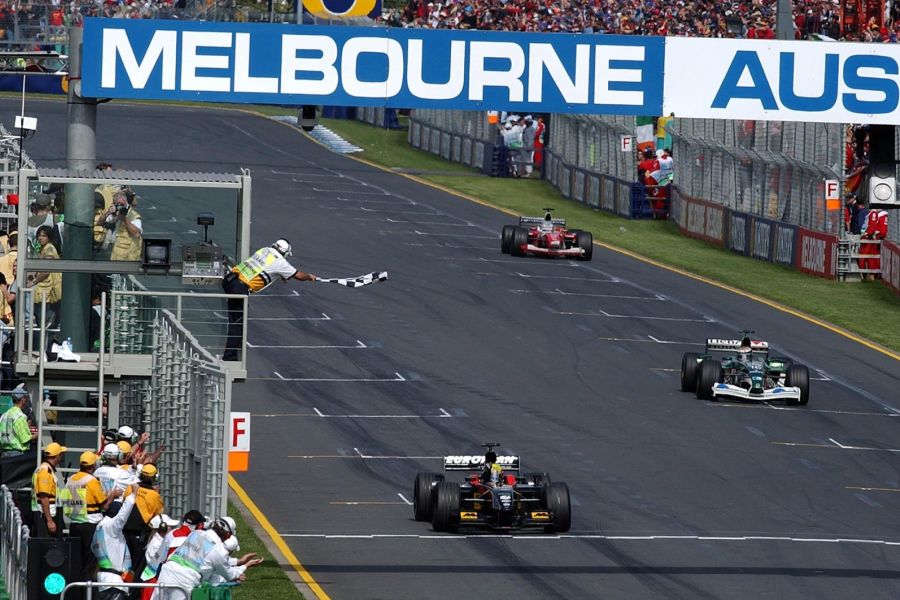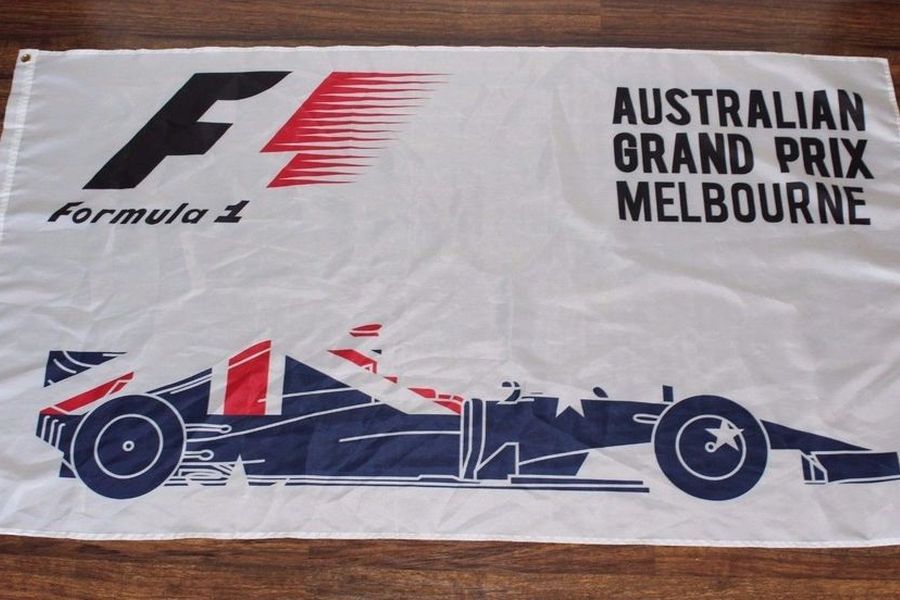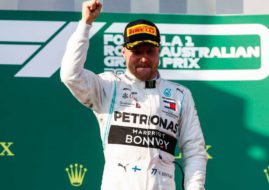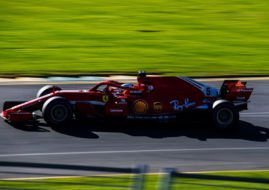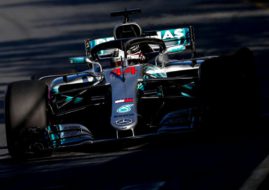90 years since the first Australian Grand Prix
The Australian Grand Prix is one of three greatest and most popular races in Australia. The other two are Bathurst 1000 and Bathurst 12 Hour at Mount Panorama Circuit.
The Australian Grand Prix was held for the first time in 1928 at Phillip Island. In the next six decades, the race took place on twenty-one different circuits and as a part of different championships. In 1985, Australian Grand Prix became the part of the Formula One World Championship, first at Adelaide Street Circuit and then, since 1996, at Melbourne Grand Prix Circuit in Albert Park.
In the 90-year history of the event, two drivers recorded four victories – Lex Davison in a period between 1954 and 1961, and Michael Schumacher in the F1 Championship between 2000 and 2004. Among manufacturers, McLaren leads with twelve victories, one more than Ferrari.
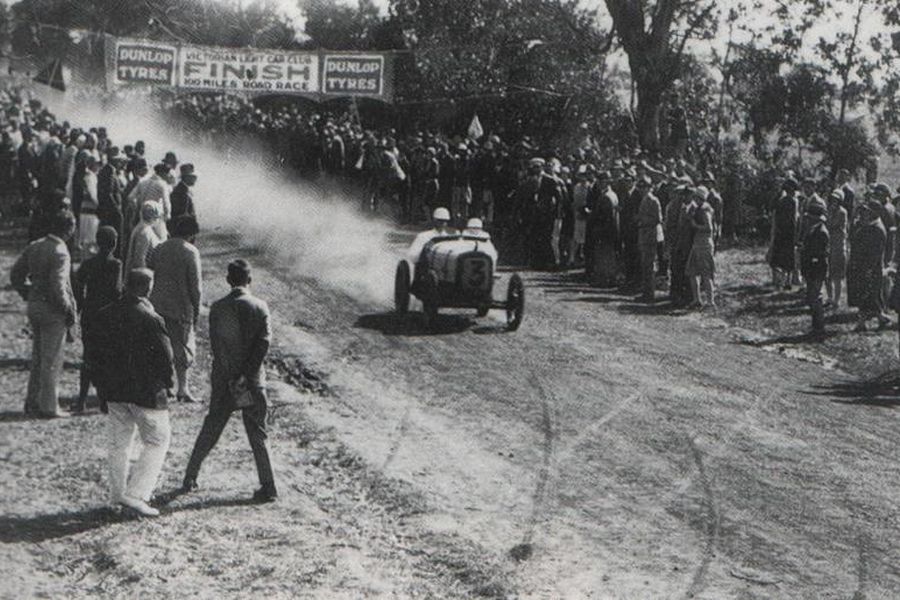
Arthur Waite won the 1928 Australian Grand Prix (100 Miles Road Race)
Australian Grand Prix started as the 100 Miles Road Race
The glorious story about Australian Grand Prix began in March 1928 at Phillip Island road course. Although now known as the first Australian Grand Prix, the race organized by the Victorian Light Car Club was actually called the 100 Miles Road Race and it did not assume the Australian Grand Prix title until some years later.
The race was open to light cars up to 2-liter engine capacity. Seventeen entrants were divided into four classes according to cylinder capacity. The event was conducted as two separate races, first in the morning for Class B and Class D entries, and the second in the afternoon for Class A and Class C cars. The overall winner with the best time was Arthur Waite, who was driving an Austin 7 in the smallest class A (up to 750cc).
Four consecutive wins for Bugatti
Arthur Terdich, who was fourth in 1928, won the race in 1929 in a Bugatti Type 37 A. It was the first of four consecutive wins for Bugatti drivers.
Bill Thompson won in 1930, Carl Junker in 1931, and then again Bill Thompson in 1932, becoming the first of multiple winners. In 1933, Bill Thompson scored his third victory, driving the #5 Riley Brooklands.
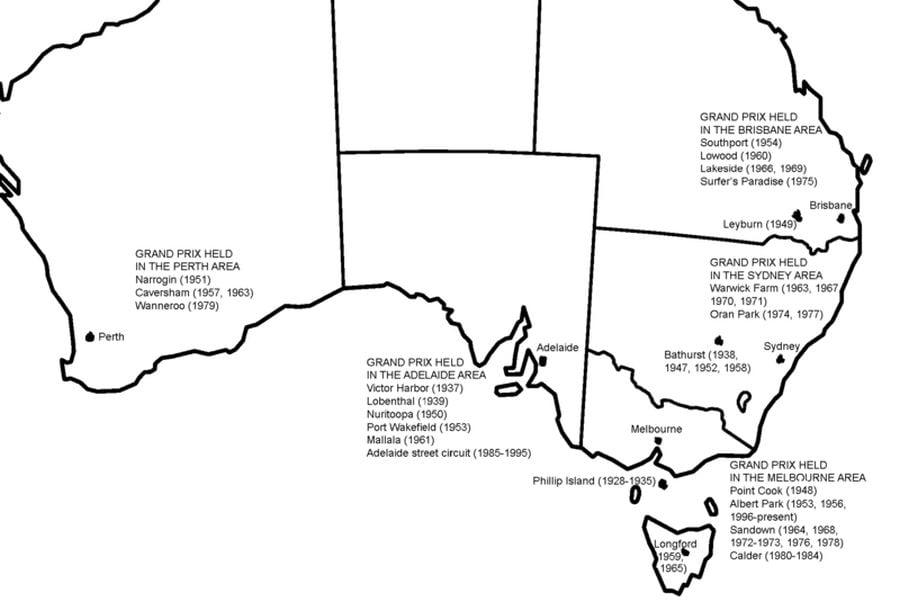
Australian Grand Prix was held on twenty-three different locations all over Australia
The race left Phillip Island in 1936
Bob Lea-Wright has won in 1934 with Singer 9 Le Mans and then Les Murphy in 1935 with MG P-Type. It was the last Australian Grand Prix at Phillip Island.
The next race, which took place on Boxing Day 1936 (December 26) was held on the temporary road circuit at Victor Harbor under the name South Australian Centenary Grand Prix. The event was later renamed to the 1937 Australian Grand Prix. In that race, Les Murphy scored his second win in an MG P-Type.
Australian Grand Prix as the first race at new Mount Panorama Circuit
The Australian Grand Prix has been revived in April 1938, serving as an inaugural event on newly-opened Mount Panorama Circuit in Bathurst. Two British drivers attended the race, Peter Whitehead and Alan Sinclair. Whitehead took the victory in the #1 ERA B Type, becoming the first non-Australian winner.
In 1939, the race took place on the Lobethal Circuit in South Australia. Alan Tomlinson won the race in an MG TA. Vern Leech lost a life in an accident, becoming the first fatal victim of the Australian Grand Prix.
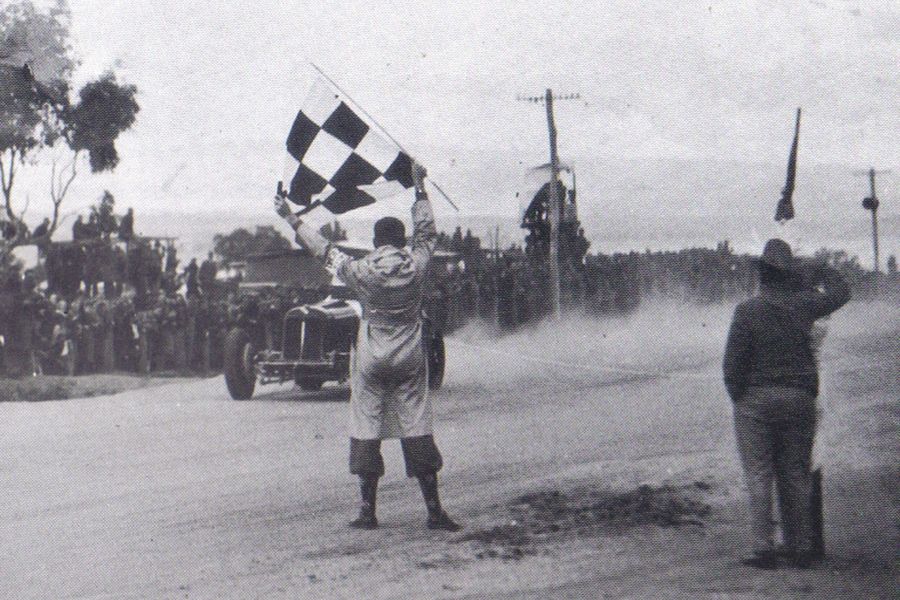
Peter Whitehead won the 1938 Australian Grand Prix at Mount Panorama Circuit
Rotational system between Australian states since 1947
After the World War II, the Australian Grand Prix resumed in 1947 at Mount Panorama with a victory of Bill Murray in an MG TC. With that race, the rotational system between the Australian states started. The next four races took place on four different circuits (Point Cook, Leyburn, Nuriootpa, Narrogin) before returning to Bathurst in 1952. After that, the hosting venues were Albert Park, Southport, Port Wakefield and Albert Park again in 1956.
The winners in that period were Frank Pratt (1948, BMW 328), John Crouch (1949, Delahaye 135MS), Doug Whiteford (1950, Ford V8 Special), Warwick Pratley (1951, GRS Ford), Doug Whiteford (1952 and 1953, Talbot-Lago T26C) and Lex Davison (1954, HWM F2-Jaguar).
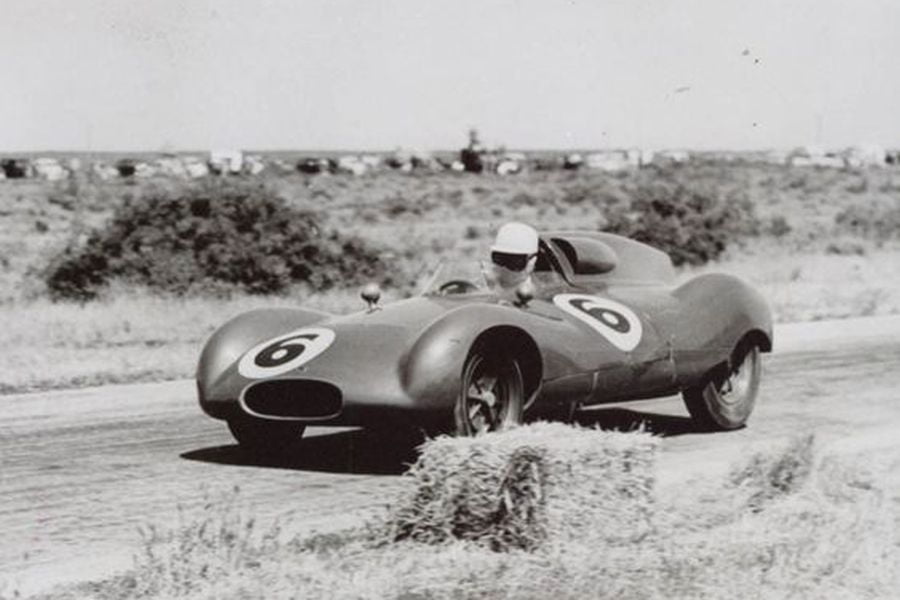
Jack Brabham’s Cooper T40 at 1955 Australian Grand Prix at Port Wakefield circuit
Jack Brabham’s win in the first ever rear-engined car
Jack Brabham took his first of three AGP wins in 1955. The race was held in October at the Port Wakefield Circuit in South Australia.
Brabham won in the #6 Cooper T40-Bristol, the first ever rear-engine car to win the Grand Prix. In the 80-lap race, he won ahead of Reg Hunt in a Maserati A6GCM and Doug Whiteford in a Talbot-Lago T26C.
Stirling Moss won the spectacular event in 1956
In 1956, the Grand Prix returned to Albert Park, hosting among others Maserati factory team with four drivers and two more British racers in Ferraris. The event capitalized a publicity of the 1956 Olympic Games which were held in Melbourne, attracting a crowd of 120,000 spectators.
Stirling Moss won the 80-lap race in the #7 Maserati 250F, beating his teammate Jean Behra and Peter Whitehead in a Ferrari 555.
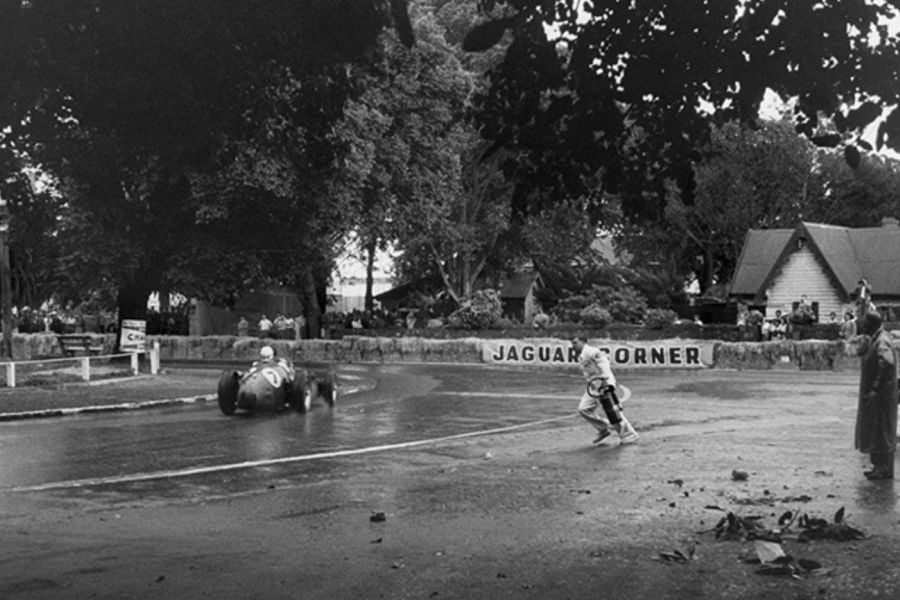
Stirling Moss in the #7 Maserati at 1956 Australian Grand Prix at Albert Park
Three more wins for Lex Davison until 1961
In 1957, the Australian Grand Prix was a part of the first ever Australian Drivers’ Championship. The race was held at Caversham Circuit in Western Australia and Lex Davison scored his second victory, sharing a Ferrari 625 with Bill Patterson.
Davison repeated a victory in a Ferrari 625 next year at Mount Panorama, equaling the record of three wins. Stan Jones and Alec Mildren were the winners in 1959 and 1960 respectively, at Longford and Lowood circuits. And then, in October 1961, Lex Davison won a race at South Australian Mallala Circuit in a Cooper T51-Climax, becoming the only four-time winner.
A new era started in 1962
A victory for Bruce McLaren in the 1962 Australian Grand Prix at Caversham circuit marked the beginning of new era. From then, Australian Grand Prix became a race dominated by professional drivers and teams rather than gentlemen amateurs who had won most races to date.
The Australian Grand Prix, together with New Zealand Grand Prix, became a popular destination for European drivers because it was held during European winter. It was the golden age for racing in the region, resulting in the creation of Tasman Series in 1964.
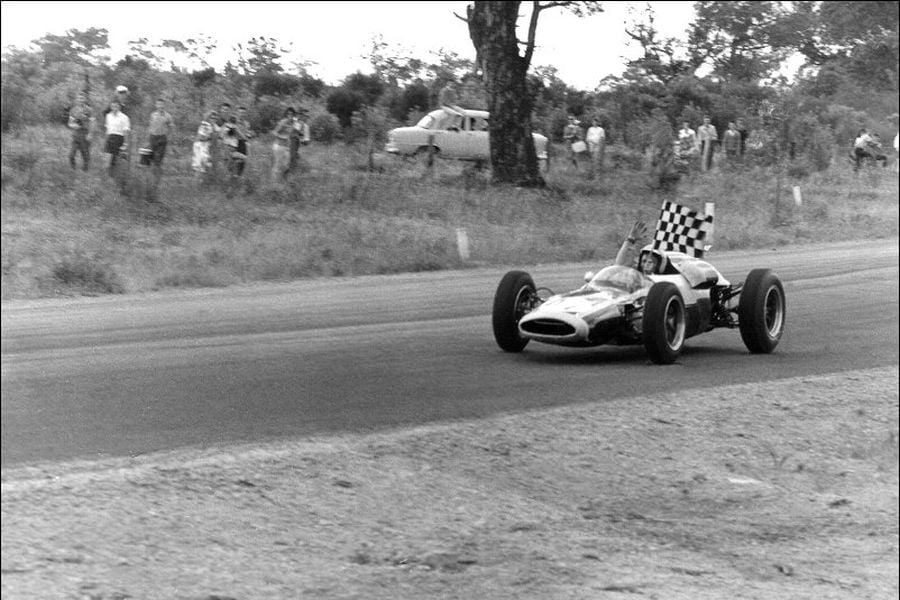
Bruce McLaren’s victory lap after he won 1962 Australian Grand Prix at Caversham circuit
A part of the Tasman Series from 1964 to 1969
Eight years after his first win, Jack Brabham won the Australian Grand Prix in 1963 (at Warwick Farm) and then again in 1964 (at Sandown). The 1964 event was a part of the inaugural season of Tasman Series.
In 1965, Bruce McLaren won at Longford Circuit in Tasmania after an intense fight against Jack Brabham. In the next three editions of the Australian Grand Prix, three British drivers won the race – Graham Hill (BRM) at Lakeside, Jackie Stewart (BRM) at Warwick Farm and Jim Clark (Lotus) at Sandown Park. Chris Amon put the New Zealand flag to the top podium spot in 1969, winning in a Ferrari 246T at Lakeside.
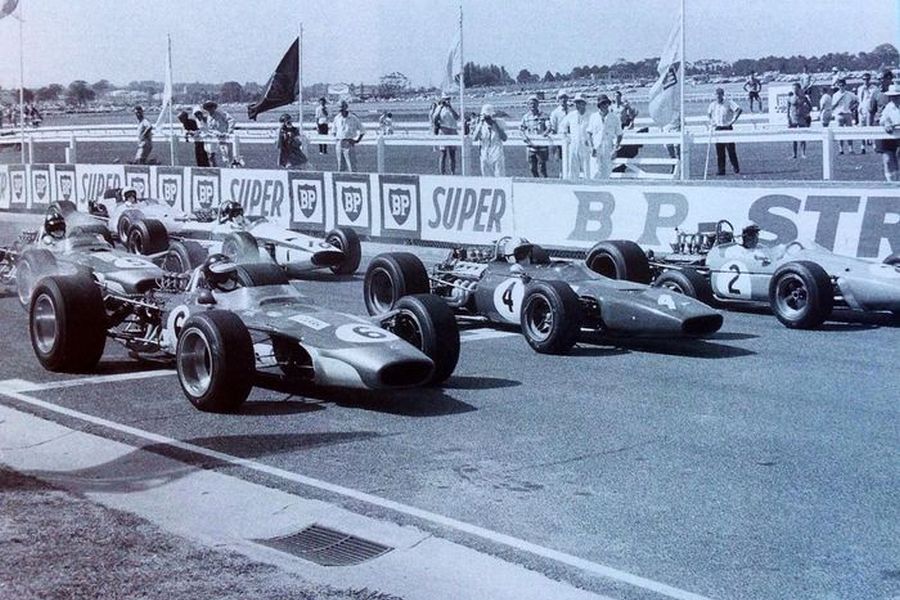
Jim Clark, Chris Amon and Jack Brabham on the front row at the 1968 Australian Grand Prix
Formula 5000 era from 1970 to 1979
In 1970, the Australian Grand Prix was not a round of either the Australian Drivers’ Championship or the Tasman Series. An era of Formula 5000 cars begun. Frank Matich won a race at Warwick Farm in a McLaren M10B. He repeated a win on the same track in 1971, driving the Matich A50-Repco Holden.
In 1972 and 1973, AGP moved to Sandown. Graham McRae scored two consecutive wins with his own-built F5000 cars, first in Leda GM1-Chevrolet and then in a McRae GM2-Chevrolet. Max Stewart became another double winner, winning the race in 1974 at Oran Park and in 1975 at Surfers Paradise.
John Goss (1976, Sandown), Warwick Brown (1977, Oran Park), Graham McRae (1978, Sandown) and Johnnie Walker (1979, Wanneroo) won four more Grand Prix events with F5000 machinery.
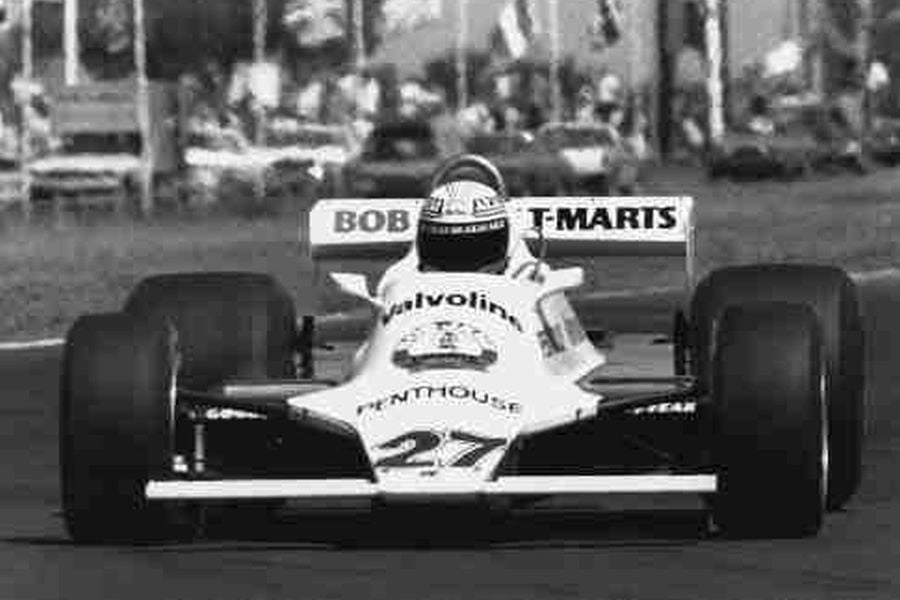
Alan Jones won the first Australian Grand Prix at Calder Park in 1980
1980 – historic win for F1 champion Alan Jones
In 1980, Formula 1 cars returned to the Australian Grand Prix. The race has been moved to the Calder Park, owned by entrepreneur Bob Jane. He recognized an opportunity when Australian Alan Jones won the Formula One World Championship, bringing the F1 Grand Prix race to his circuit.
Freshly crowned F1 champion led the field in the #27 Williams FW07-Cosworth and won the race ahead of Bruno Giacomelli and Alfredo Costanzo. By winning the AGP, Alan Jones joined his father Stan Jones to become the first ever father and son to win the race. As of the 2017 race, Alan Jones remains the last Australian driver to have won the Australian Grand Prix.
Calder Park was hosting Australian Grand Prix until 1984
After a disintegration of Formula 5000, Bob Jane decided to concentrate the next four Grands Prix events on the Formula Pacific cars, also inviting Formula One drivers as guests. Brazilian Roberto Moreno dominated this era, winning three of the four races, all three with Ralt-Ford cars.
In 1981, the 22-year-old Moreno beat freshly crowned F1 world champion Nelson Piquet. In 1984, Moreno defeated another F1 champion, Keke Rosberg. Besides Moreno, one more winner at Calder Park was Alain Prost in 1982.
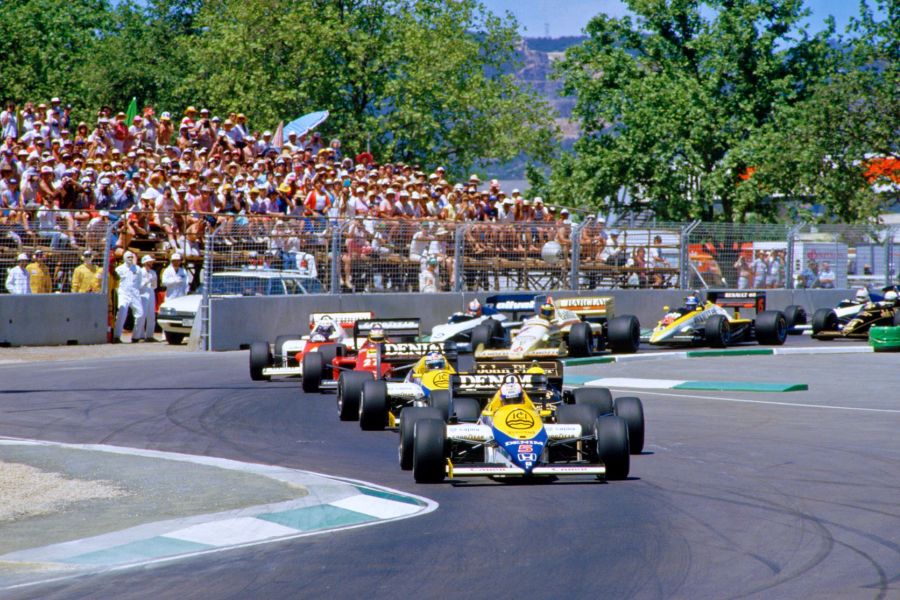
1985 Australian Grand Prix at Adelaide Street Circuit
AGP as a part of the F1 World Championship since 1985
It was a time to bring the Formula One World Championship to Australia in 1985. Bob Jane’s attempt to bring the championship to Calder Park failed, same as a bid by Sandown. The more attractive offer came from Adelaide and the Australian Grand Prix has been moved from Victoria to South Australia.
The 16-turn 3.780 km long circuit at the streets of Adelaide hosted the Formula One Championship Grand Prix for the first time in November 1985. It was the sixteenth and final race of the championship. The venue immediately became popular among racers and fans. The professional way in which the event was organized was sufficiently positive to see the promoters awarded the Formula One Promotional Trophy for 1985.
Keke Rosberg was the winner of the 1985 Australian Grand Prix in the #6 Williams-Honda, ahead of two Ligiers driven by Jacques Laffite and Philippe Streiff. The 1985 race wasn’t decisive for the championship because Alain Prost already secured a title.
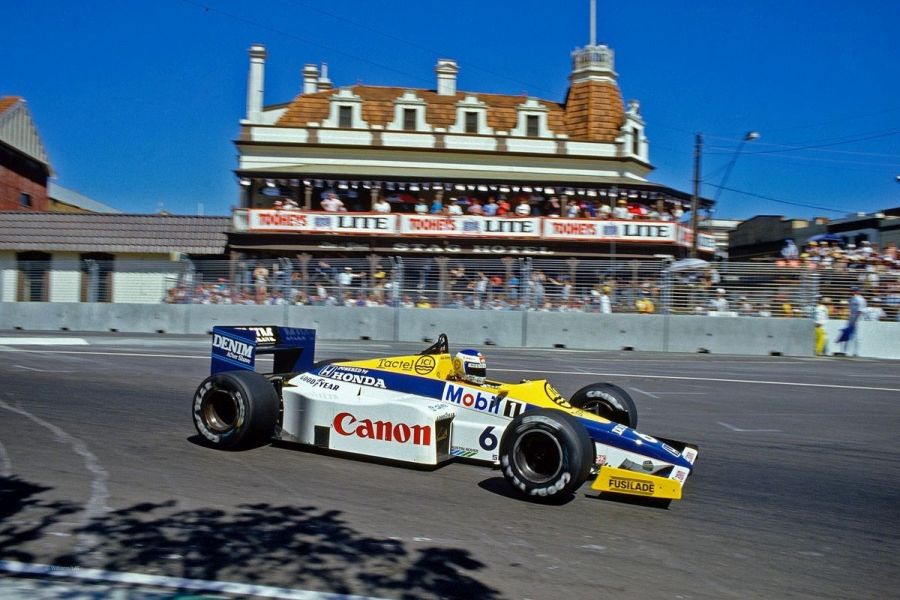
Keke Rosberg was the first winner of the Australian Grand Prix in the F1 Championship
Prost, Senna, Berger were multiple winners at Adelaide
In 1986, Alain Prost won the race and the championship in a McLaren-TAG. Ferrari’s Gerhard Berger won in 1987 and then again Alain Prost was the winner in 1988. The championship title went to Ayrton Senna, who was second in the race.
Senna himself won a race at Adelaide twice, in 1991 and 1993. Gerhard Berger was the winner one more time, in 1992, driving for a McLaren-Honda. Other winners at Adelaide were Thierry Boutsen (1989), Nelson Piquet (1990), Nigel Mansell (1994) and Damon Hill (1995).
Moving to Melbourne’s Albert Park in 1996
The campaign of moving the F1 Grand Prix from Adelaide to Melbourne was finalized in 1993. F1 supremo Bernie Ecclestone signed a deal for a return to Albert Park in 1996. The rebuilt 16-turn 5.3 km long circuit hosted the Australian Grand Prix for the first time in March 1996.
Unlike Adelaide’s race, which was the season-closing round of the F1 Championship, Melbourne’s race became the season-opening race of the world’s premier single-seater competition.

Rubens Barichello, Michael Schumacher and Ralf Schumacher at 2000 Australian Grand Prix podium
Four wins for Michael Schumacher
Damon Hill, the last winner at Adelaide, was the first winner at new Melbourne Grand Prix Circuit, driving again a Williams-Renault. David Coulthard (McLaren-Mercedes), Mika Häkkinen (McLaren-Mercedes) and Eddie Irvine (Ferrari) triumphed at Albert Park before Michael Schumacher‘s first win in 2000. Ferrari driver was sharing a podium with his brother Ralf, who finished in the third place.
Schumacher climbed to the top podium spot for three years in a row from 2000 to 2002. In 2003, David Coulthard defeated him and then, in 2004, Schumacher clinched his fourth win in the Australian Grand Prix, becoming the most successful driver in a history of the event.
Button, Raikkonen, Hamilton, Vettel, Rosberg as multiple winners
In the post-Schumacher era, several drivers won the Australian Grand Prix more than once. Jenson Button was the first to win three times (2009, 2010, 2012) and then Sebastian Vettel equaled him after winning third time in 2018. He previously won in 2011 and 2017.
Two-time winners were Kimi Raikkonen (2007, 2013), Lewis Hamilton (2008, 2015) and Nico Rosberg (2014, 2016). One victory went to Giancarlo Fisichella (2005) and Fernando Alonso (2006).
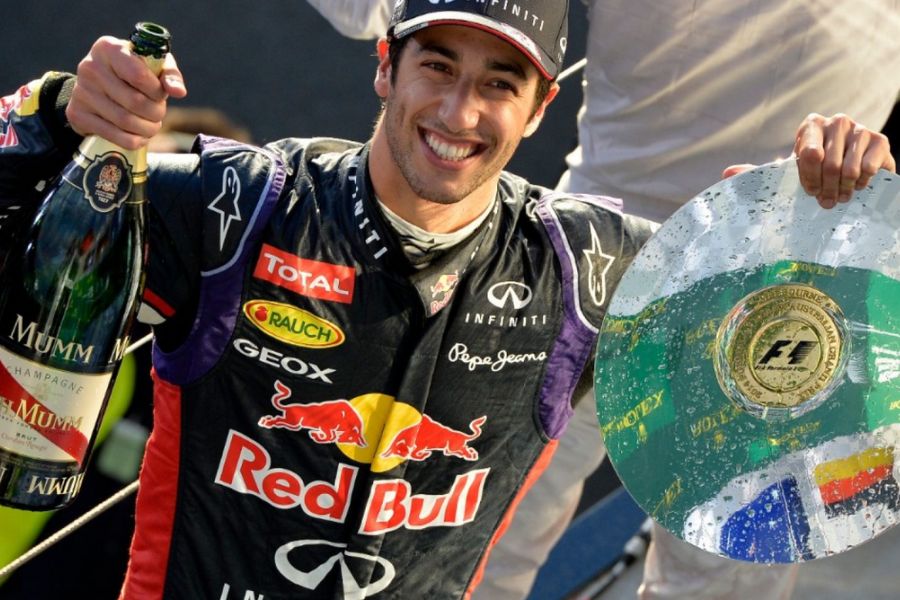
Daniel Ricciardo was stripped of the podium in 2014
Rare Australians in the Australian Grand Prix
Since becoming a round of the F1 World Championship in 1985, only four Australians were racing in the Australian Grand Prix. Alan Jones appeared in 1985 and 1986, David Brabham also two times (1990 and 1994), while Mark Webber was active from 2002 to 2013. Neither one of them managed to win or to reach a podium.
Currently, the only Australian on the F1 grid is Daniel Ricciardo. He finished second in the 2014 race but was disqualified post-race. The last Australian driver to finish on a podium was John Smith in 1983 while the last Australian winner was Alan Jones in 1980.
Photos: Wikipedia, Formula 1, Eric Vargioglu/Red Bull, terrywalkersplace.com,



